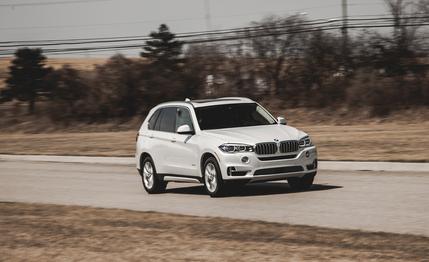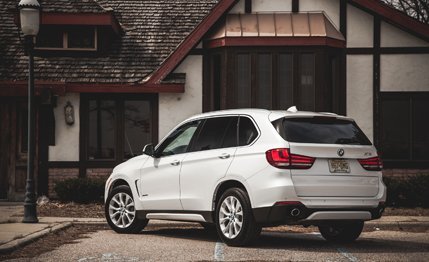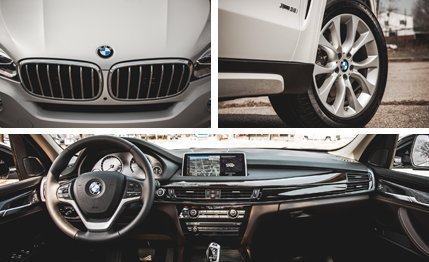
 Instrumented Test
Instrumented Test
Value is a key element in automotive purchase decisions, but its definition varies considerably according to the buyer’s proclivities, which can lead to some interesting arithmetic. Consider the new BMW X5. If power absolutely rules your gotta-have-it list of traits, the choice is pretty simple: You need the X5 xDrive50i, with its 445-hp, 4.4-liter twin-turbo V-8, which moves the 2.5-plus-ton SUV from 0-to-60 mph in a darn snappy 4.3 seconds. It’s the hottest X5 you can buy, at least until a next-gen M version comes along.
But if your buyer’s brain operates on a system of checks and balances, you’ll be feeding other factors into the equation. For example: the base price of the X5 xDrive50i—$69,125—is $13,100 north of the base for the X5 xDrive35i. The 35i is propelled by a turbocharged inline-six that generates 300 horsepower and 300 lb-ft of torque. That means you’d be paying $6550 for each of the 50i’s additional cylinders and a little over $90 for each additional pony.


How about the 0-to-60 dash? The 35i does it in 6.0 seconds, not quite enough to induce brownouts, but respectable. Shaving 1.7 seconds off that time with the 50i costs a little under 1000 bucks per 10th.
The Hurry Games
It’s rare for us to advocate going a little slower, but in vehicles such as this, the need for haste is offset by the cost-to-benefit ratio. Why spend a lot of dough to propel a heavy brick to 60 mph in less than five seconds, when you can achieve that in something smaller and handier for considerably less? And this doesn’t even include fuel-economy (although the term is almost oxymoronic in the SUV realm). The X5 50i we tested recently was EPA-rated for 14 mpg city and 22 highway, and we recorded 15 mpg in our travels. Our X5 35i test SUV is rated 18/27, and we achieved 21 mpg—burning premium fuel in both.
Inline-sixes have long been a BMW staple, and the boosted 3.0-liter in the 35i is a sweetheart. It’s smooth and quiet, with a torque curve that looks like the profile of the old airport mesa in St. George, Utah—long, high, and flat, with all 300 lb-ft online from 1300 rpm, barely off idle, to 5000. The single twin-scroll turbo delivers instant throttle response, and the eight-speed automatic is nicely programmed to make the most of it. Multiple downshifts for passing don’t require much of a prod on the accelerator, and the transmission goes about its business seamlessly in full auto mode.
However, for drivers who want to sometimes shift for themselves, this device leaves much to be desired. The electronic shifter, common to a number of current BMWs, is irritatingly counterintuitive and doesn’t really lend itself to manual operation. Our test vehicle wasn’t equipped with steering-wheel paddles.


The electric power steering, augmented in our test car by BMW’s new active steering feature ($1550), might be in violation of the Freedom of Information Act, substituting effort for tactile feedback. That’s not a particularly good dynamic foundation for a quick ratio—2.2 turns lock-to-lock—although that does add some sense of agility to this sizable SUV.
The agility factor could be further improved by opting for performance tires. Our tester was shod with Goodyear Eagle LS2 255/50 all-season run-flats on optional 19-inch alloy wheels. Running on this rubber, the X5 delivered a modest 0.81 on the skidpad, experienced abundant understeer, and had a slightly stiff ride over sharp bumps. Our measured braking distance—175 feet from 70 mph—was merely okay for this class, although fade-free stop after stop.